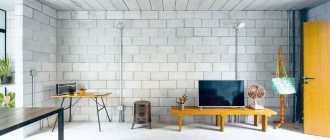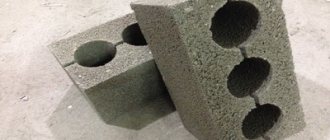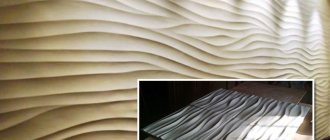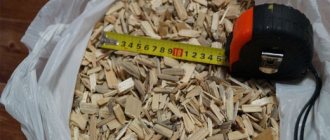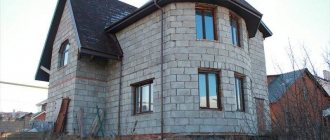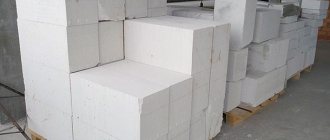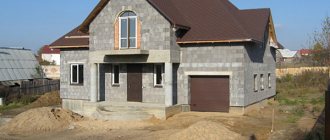How many cubes of wood concrete are on a pallet?
The concept of specific gravity. Weight of an arbolite cube and the weight of an arbolite block
| Block type | Block volume, m3 | Quantity on pallet , pcs. |
| Standard 500 x 300 x 250 mm | 0,0375 | 50* |
| Standard 500 x 300 x 200 mm | 0,03 | 48* |
| Foam arbolite 500 x 300 x 250 mm | 0,0375 | 50* |
| Partition 500 x 300 x 142 mm | 0,0213 | 48 |
Arbolite calculation
Before purchasing, you need to find out the number of blocks needed. There are construction calculators on the Internet for calculations like the Chinese, but you can perform the calculation correctly only after understanding the topic. If you were designed by a good architect who loves the job, then you most likely should already know what materials will be needed in construction.
Typically only two sizes are used:
- 500x300x200 mm - for walls;
- 500x150x120 mm - for interior partitions;
- Often there are projects with 400x200x200 mm.
Without a detailed description of the project, you will not be able to find out how much wood concrete is needed for construction. You will have to act at random.
It is also necessary to remember that there are no houses without windows and doors, and their square footage also needs to be calculated in advance.
For a complete calculation, you, of course, need to know the length of the load-bearing walls. Thickness is no less important, but this figure is 99.9% the same - 300 mm (load-bearing wall) and 150 mm (interior wall). If the building has more than one floor, you should of course know the height of each.
The calculation itself is divided into 5 steps:
- First of all, calculate the perimeter of the walls, to do this you just need to fold them - this will be the total length;
- Next, add up the height of each floor;
- Then we multiply the height by the length of the load-bearing walls;
- Don’t forget to subtract window openings and doors;
- Multiply the result by the number of blocks needed to lay 1 m2 of wall.
If this is already behind you, proceed to the calculation stage.
Let's take numbers out of nowhere (in your case, from measurements):
- let's say the length of all walls is 28 m;
- wall height – 7 m;
- total area of all windows and doors – 13 m2;
- We take 500x300x200 blocks as the basis of the house; to build 1 square meter you need 10 such blocks.
We count: x= (28*7-13)*10. As a result, we get 1830 blocks.
Do not forget that there are defects and defects, so you need to take 8% more.
Calculation of wood concrete in a cube
To calculate everything inside and out, you need to know how many blocks are in one cube. First, consider the standards of load-bearing walls 500x300x200 mm - in a cubic meter you get 33.3 pieces.
Having carried out the preliminary calculations above, we learned that to build a 28x7 we need 1830 pieces, let’s convert our numbers into volume:
V =1830/33=55.5 m3.
It is also worth knowing the volume of bulkheads, for filling which arbolite 500x150x200 mm is always used, in one cube there are 66.6 pieces. Even no less often, when constructing a building, carbolite of size 400x200x200 is used - in this case there will be 62 blocks in 1 m3.
We have given you the necessary knowledge needed to perform the calculation of wood concrete.
The composition of wood concrete and its effect on the quality of the material
The main components of this material are the following:
- Water;
- Chemical additives;
- Cement;
- Wood chips.
The size of the chips is very important. To obtain wood concrete products with the required characteristics, it is necessary to use wood chips that are strictly standardized by the state standard. Moreover, its dimensions are 5x10x40 millimeters.
All other materials, including wood processing waste, can only spoil the properties of the product. These are tyrsa, straw, shavings, sawdust and the like. For maximum quality of wood concrete products, it is necessary to use only wood chips without foreign impurities (leaves, bark or soil). The presence of 5-10% impurities is allowed, but ideally there should be none.
For the buyer, it does not matter what kind of wood the chips are from, but for technologists this affects the process of preparing the mixture. In particular, this affects the dosage of mineralizers and the determination of the degree of compaction. For example, if larch chips are used, then twice as many additives are needed as with other coniferous trees. Typically, spruce and pine are used for the production of wood concrete; deciduous trees are used much less frequently.
Composition of arbolite block
Calculation result
Description of the results of calculating wood concrete blocks in the online calculator:
- The perimeter of enclosing structures is the sum of the lengths of all enclosing structures, units of measurement are meters;
- Wall area – the area of the external sides of the enclosing structures, excluding gables/doors/windows, units of measurement – square meters;
- The total area of the gables is the area of masonry on the gables, which is added to the area of masonry on the walls;
- The total area of windows is the area of all windows, which is subtracted from the area of the walls, units of measurement are square meters;
- The total area of the doors is the total area of the doors, which is subtracted from the area of the walls, the units of measurement are square meters;
- The total area of the walls is the area of the external sides of the enclosing structures, taking into account gables, doors and windows, units of measurement – square meters;
- Total number of blocks – the number of blocks required to construct a structure according to the specified parameters, units of measurement – pieces;
- The total weight of the blocks is the weight of all the blocks required to construct the structure according to the specified parameters, units of measurement are kilograms. A useful parameter when calculating delivery;
- The total volume of blocks is the volume of blocks required for construction, units of measurement are cubic meters. A useful parameter when calculating delivery;
- Total amount of mortar - the total amount of mortar required to erect a structure according to the specified parameters, units of measurement - cubic meters;
- The total weight of the mortar is the approximate weight of the mortar required for masonry according to the specified parameters. Weight may vary depending on the volumetric weight of the components and their ratio in the solution; units of measurement are kilograms;
- Total weight is the approximate weight of the finished walls, taking into account blocks, mortar and masonry mesh, units of measurement are kilograms;
- Wall thickness – the thickness of the finished wall including seams, units of measurement – millimeters;
- Number of rows including seams - the number of rows is given without taking into account the gables, depends on the overall dimensions of the selected block and the thickness of the mortar in the masonry, units of measurement - pieces;
- Quantity of masonry mesh - the total amount of masonry mesh used to strengthen the structure being built, units of measurement are meters;
- The optimal height of the walls is the height of the walls, excluding the gables, which is obtained when laying blocks, the selected size and thickness of the mortar in the masonry, units of measurement are meters;
- Load on the foundation from the walls - this parameter is necessary for choosing a foundation. Given without taking into account the weight of the floors and roof.
Manufacturing process and composition of wood concrete
The presence or absence of negative properties of this material directly depends on how well certain processes are performed. This is due to the fact that wood concrete is a type of lightweight coarse-cell concrete, in which the filler is wood chips, forming an integral structure with cement mortar.
The format in which wood concrete blocks are sold has different shapes, sizes and prices:
- Hollow blocks;
- Large format blocks;
- Plates.
Photo: wood concrete slabs
The most widely used are wood concrete blocks with dimensions of 500x300x200 millimeters. But due to increasing demand, other size formats began to be produced, for example, 250x300x500.
The wood concrete manufacturing technology itself is so simple that you can produce wood concrete blocks with your own hands. Its essence lies in the correct mixing of all the components that make up the material. But the quality of products depends on strict compliance with a number of requirements specified in the relevant technical documentation.
Weight of wood concrete is 1 m3. Specifications
Wood concrete, sometimes called wood concrete, consists of 75–80% wood chips.
Rice straw, flax seeds, and cotton stalks can be used in the same capacity. This material should be distinguished from the more well-known sawdust concrete: here the size of the chips is regulated by GOST and much more strictly, and the concrete does not contain sand. According to its properties, wood concrete is divided into 2 groups:
- thermal insulation – with a higher wood content and lower density – up to 500 kg/cu.m. m. It is characterized by high porosity, that is, it includes a lot of air, which provides excellent thermal insulation properties;
- structural - with a high cement content and density from 500 to 800 kg/cubic. m. This option can be used for the construction of load-bearing and self-supporting walls. Its thermal insulation performance is lower, but still superior to other concretes of the same density.
GOST regulates the strength, density and compressive strength of wood concrete; these comparative characteristics are presented in the table below.
| Type of wood concrete | Compressive strength class | Strength grade (axial compression) | Average density, kg/cube m. |
| Thermal insulation | B0.35 | M5 | 400–500 |
| B0.75 | – | 500–650 | |
| B1.0 | M15 | 500 | |
| Structural | B1.5 | – | 500–650 |
| B2.0 | M25 | 500–700 | |
| B2.5 | M35 | 600–750 | |
| B3.5 | M50 | 700–850 |
Let us also mention the specific gravity of wood concrete (1m3). As can be seen from the table in terms of density, wood concrete is a very light material. A block of wood concrete measuring 500*250*300 mm weighs only 24 kg.
GOST regulates the dimensions of products made from blocks. The following types are available:
- large – 500*250*300 mm;
- medium - 500*250*200 mm;
- narrow – 500*250*150 mm;
- U-shaped jumpers – 1500*250*300 mm.
By agreement with the customer, and if this does not contradict technical restrictions, blocks of other sizes can be produced. The permissible error in their length and height is 5 mm. In practice, such a small error is found only in the best manufacturers.
It is allowed to reinforce the product with steel mesh and rods. In this case, the material characteristics change.
Material characteristics
Arbolite blocks have several components - a base, binders and additives to improve the quality of the material. The new composite material has the advantages of all its components, and also allows you to get rid of their disadvantages.
Block and monolithic material first appeared in the thirties in Holland. Over the next twenty years, wood concrete spread throughout Europe, America and came to the Soviet Union, where it was widely used in the construction and finishing of finished structures. Industrial material consists of the following components:
- wood chips;
- cement;
- water;
- fillers.
The block recipe uses pine chips, woody stems, cotton or rice straw. Cement plays the role of the main binding component; the density and strength of wood concrete depends on it. Fillers are needed to neutralize wood sugars, which cause rot and attract insects. Aluminum sulfate, calcium nitrate or liquid glass are used in production mixtures. Water dissolves all fillers and catalyzes the cement reaction. When produced at special enterprises, the recipe uses 500 ml of liquid glass, 25 kg of cement, 40 liters of water and 130 liters of wood chips.
The characteristics of wood concrete combine the features of cement and wood materials. The second name of the material - wood concrete - was formed precisely because of the presence of wood chips in the composition. In terms of technical indicators, wood concrete is superior to brick in terms of thermal conductivity and ease of installation.
Main characteristics:
- density - 600-800 kg per cubic meter;
- thermal conductivity - 0.10-0.17 W/(m*s);
- frost resistance - a wet cube can be frozen 30-50 times;
- water absorption - 50-85%;
- biostability - fifth group;
- shrinkage - 0.5%;
- sound insulation - 0.15% transmitted sounds up to 2000 Hz;
- fire resistance - 60-90 minutes before destruction in a flame.
Indicators may vary depending on the density of the material, which depends on the type of cement and fillers. The use of plaster or decorative panels to cover the facade allows you to reduce some parameters of wood concrete.
Cost of wood concrete blocks per cube and piece
Wood concrete (wood block, sawdust concrete) is an environmentally friendly building material with unique characteristics; it is a type of lightweight concrete based on wood chips with the addition of high-grade cement and a chemical hardener. Depending on the specific technical characteristics established by GOST 19 222-84, it is advisable to buy wood concrete for the construction of low-rise buildings (up to 3 floors), country houses, industrial, utility and domestic buildings. Due to its high quality and affordable price parameters, it is perfect for the construction of garages, bathhouses, household buildings and fences.
Cost of products
The price of each product depends on a number of factors: the quality of the components used, size and manufacturer. It can be assigned either per piece or per cube of material. In different stores, the price of a product from the same manufacturer may differ, but this difference will be insignificant.
As an example, the following summary table with the price of wood concrete blocks of various sizes can be given:
| Purpose of the block | Block size, mm. | Number of blocks in a cube, pieces | Brand | Strength class | Price per cube, rub. |
| For walls | 200x300x500 | 33,3 | M100 | B 7.5 | 3 900 |
| 250x300x500 | 26,6 | M100 | B 7.5 | ||
| 200x400x500 | 25 | M100 | B 7.5 | ||
| For partitions | 200x200x500 | 50 | M100 | B 7.5 | |
| 250x200x500 | 40 | M100 | B 7.5 |
As you can see, the price is set per cube and it is the same for all products. However, if you pay per piece, the price will be different. After all, it is quite natural that there are fewer blocks with larger sizes in one cube, and accordingly their price is higher. And yet, wood concrete blocks, despite some shortcomings, are in sufficient demand.
What is an arbolite block
When building this or that object, based on the finished project, you simply need to know how many wood concrete blocks are in the cube. To understand the scope of all the work and the price tag that will result in a cube of wood concrete. Projects usually describe how many cubes we need to cover with wood concrete, but how many pieces of wood concrete in one cube still need to be counted.
Arbolite usually replaces concrete and brick. This material is even better than those listed earlier, since it has good durability and does not conduct temperature well (accordingly, it will not be so cold in winter). It is usually used to reduce the amount of work, because if compared with the same brick, building a house from wood concrete will take much less time and money.
What determines glue consumption?
Regardless of the manufacturer - domestic or foreign, the use of a certain amount of adhesive mass for laying aerated concrete blocks depends on the following factors:
- Individual construction conditions.
- A certain amount of composition, represented by an estimate.
- Number of floors, and calculation of quantity per 1m2 or 1m3.
- Laying process and technology.
- The presence of reinforcing layers and norms of the laid layer.
- Technical characteristics of the composition.
- Defects and low quality of aerated concrete blocks purchased by the customer.
- Ambient temperature and humidity.
It often happens that during the calculations indicated in the estimate, a discrepancy between the planned and final indicators is discovered, in accordance with the norms adopted, where the calculation standard is 26-30 kg per 1 m3. Therefore, glue is always taken with a reserve - 1 bag more.
It is also worth paying attention to the composition of the mixture when calculating. If the composition contains a large amount of fine sand, additives and binders, then the actual glue consumption always increases
Here you should pay attention to the mixture consumption indicated in the manufacturer’s instructions - a good brand will definitely indicate the necessary figures.
The maximum permissible amount of mixture per gas block is 4 mm. For example, when using reinforcement, more glue needs to be placed on the surface. This comes out to about + 1 m3, therefore, the extra volume is added to the previously obtained figure.
If the cellular concrete is of poor quality, chipping and leveling the surface can lead to excessive consumption of adhesive material in n-progression, so most of the adhesive material can be used to level the seams and change the geometry of the blocks.
The season of operation, the amount and temperature of water poured in, and the resulting consistency also matter. In the warm season, less material is consumed, since the components mix well with water, which is about +16-18 °C.
To avoid excess glue consumption, it is advisable to:
- Use leveling of surface layers using a tool (grater, notched trowel).
- Operate at a temperature of +15-20 °C.
- Use a compound with the specified fine grain size.
- Make uniform thin laying.
- Follow the instructions that come with the dry material.
Moisture absorption
The characteristics of wood concrete regarding moisture absorption are as follows:
- thermal insulation products have a value of 85%;
- structural – 75%.
Since the material contains cement and sawdust glued together, water accumulating on the surface flows freely through the block. Everything is simple here: when liquid gets on the material, air is displaced from the pores. When the source is removed, the liquid flows back out and the stone quickly dries out.
While in masonry, the products practically do not absorb moisture from the external environment. Cement and mineralized sawdust are non-hygroscopic and therefore poorly wetted. That is why wood concrete is used for the construction of baths and other rooms with high humidity.
It is noteworthy that with abundant watering of wood concrete walls, water can penetrate into the room. That is why the walls must be plastered and the façade finished.
